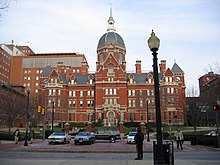Johns Hopkins Hospital
The Johns Hopkins Hospital is one of the best hospitals in the United States . It is located in Baltimore, Maryland . The founding of this teaching hospital in 1889 goes back to the philanthropist Johns Hopkins . It is part of the Johns Hopkins University Medical School , which is one of the best medical schools in the United States. In 1991–2011, the hospital was rated the best hospital in the United States. It was the only hospital in US history to retain this title for 21 years in a row. In particular, the departments for rheumatology, neurosurgery, radiology, urology, ear, nose and throat medicine, psychiatry and geriatrics are considered to be world leaders.
history
Johns Hopkins was a merchant and banker who made a will in his will of seven million dollars to the establishment of two institutions. Shortly before his death, he appointed two trustees to take care of the liquidation. In addition, Johns Hopkins has earmarked two lots in Baltimore for the construction of a hospital.
Hopkins' vision was that the Johns Hopkins Hospital should have the quality of facilities and medical care of the best American and European hospitals. The trustees should ensure this standard by selecting suitable doctors.
For Hopkins, the collaboration between university operations and the hospital sector was important. Hopkins' intention soon began to bear fruit. The Johns Hopkins Hospital became a pioneer in many areas. It allowed women to work as doctors, for the first time rubber gloves were worn during operations in the hospital and dialysis was also introduced into everyday clinical practice here.
The hospital already had a recovery room with three beds for neurosurgical patients as early as 1923.
Scientific successes
Some of the hospital's achievements have been honored with Nobel Prizes . Working in the field of enzymes laid the foundation for modern genetic engineering. The discovery of opiates in the brain led to the rapid development of neurotransmitter research . There was also outstanding work in the areas of endocrinology , urology , paediatrics and neurosurgery .
Effects on Medical Education in the United States
During his lifetime, Johns Hopkins noticed the chaos in the training of doctors in the USA. The medical offspring at that time were taught in purely commercial schools and received their first practical experience only after the end of their training from practicing doctors. For Hopkins this was not an acceptable state of affairs. He wanted to combine training and everyday clinical work. At Johns Hopkins Hospital, for example, he created a strict entrance examination, a regulated curriculum and theoretical training, which was combined with practical at the hospital bed.
To achieve his goals, Hopkins employed four enthusiastic young doctors who were later called the "Big Four". They were William Henry Welch , William Osler , William Stewart Halsted , and Howard Atwood Kelly . They were offered an attractive area of research and the financial security to carry out their work. In this way this work differed significantly from the usual clinical work, where clinical research was always only a small and financially unattractive part of the work.
Admission of students required a good knowledge of chemistry , biology and physics . Here one leaned closely on the training course of German universities, which did not exist in the USA until then. After passing the entrance examination, a quick start of the course was ensured. The approach of the Johns Hopkins Hospital was very different from that practiced at the end of the 19th century in other educational institutions, in which the economic circumstances of the applicants determined their suitability and progress.
Gifted women were accepted at Hopkins Hospital from the start. So worked Dorothy Mabel Reed Mendenhall successful here in the field of Hodgkin's lymphoma , also known as Hodgkin's disease is called.
The class sizes were significantly smaller than was usual in other training institutions, which enabled successful learning. There was close cooperation between the clinic staff and the students, which significantly promoted the practical relevance of the work. The training, which lasted four years, required intensive study, but also offered the opportunity to cooperate with experts and learn from their experiences. As a novelty, the Hopkins Hospital introduced the continuation of training after the final examination, a procedure that soon caught on nationwide.
A 1910 study found that education at Johns Hopkins Hospital was leading, followed by Washington University , Vanderbilt University , University of Iowa , Duke University School of Medicine, and the University of Rochester .
See also
Web links
Individual evidence
- ^ Best Hospitals 2010/11 - The Honor Roll
- ↑ The Johns Hopkins Hospital Ranked # 1 in the Nation in 2013 , accessed December 24, 2013.
- ↑ Michael Heck, Michael Fresenius: Repetitorium Anaesthesiologie. Preparation for the anesthesiological specialist examination and the European diploma in anesthesiology. 3rd, completely revised edition. Springer, Berlin / Heidelberg / New York et al. 2001, ISBN 3-540-67331-8 , p. 803.
- ↑ Facts and Figures 2004–2005. ( Memento of the original from September 27, 2007 in the Internet Archive ) Info: The archive link was inserted automatically and has not yet been checked. Please check the original and archive link according to the instructions and then remove this notice. (PDF; 2.2 MB) page 45. Johns Hopkins Medicine 2005.
Coordinates: 39 ° 17 ′ 49 " N , 76 ° 35 ′ 33" W.

